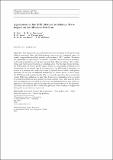Application of the SPH method to solitary wave impact on an offshore platform
Author(s)
Thyagarajan, A.; IJzermans, R. H. A.; van Beest, B. W. H.; Pan, Kai; Williams, John R.; Jones, Bruce David; ... Show more Show less
Download40571_2015_69_ReferencePDF.pdf (7.185Mb)
OPEN_ACCESS_POLICY
Open Access Policy
Creative Commons Attribution-Noncommercial-Share Alike
Terms of use
Metadata
Show full item recordAbstract
This paper investigates the interaction between large waves and floating offshore structures. Here, the fluid–structure interaction is considered using the weakly compressible smoothed particle hydrodynamics (SPH) method. To ensure the applicability of this method, we validate its prediction for fluid forces and rigid-body motion against two sets of experimental data. These are impact due to dam break, and wave induced motion of a floating cube. For the dam break problem, the SPH method is used to predict impact forces on a rectangular column located downstream. In the second case of a floating cube, the SPH method simulates the motion of a buoyant cube under the action of induced waves, where a wall placed upstream of the cube is displaced sinusoidally to induce waves. In both cases, the SPH framework implemented is able to accurately reproduce the experimental results. Following validation, we apply this framework to simulation of a toy model of a tension-leg platform upon impact of a large solitary wave. This analysis shows that the platform may be pulled into the water by stretched tension legs, where the extension of the tension legs also governs the rotational behavior of the platform. The result also indicates that a tension-leg platform is very unlikely to topple over during the arrival of an extreme wave.
Date issued
2015-09Department
Massachusetts Institute of Technology. Department of Civil and Environmental EngineeringJournal
Computational Particle Mechanics
Publisher
Springer International Publishing
Citation
Pan, K. et al. “Application of the SPH Method to Solitary Wave Impact on an Offshore Platform.” Computational Particle Mechanics 3.2 (2016): 155–166.
Version: Author's final manuscript
ISSN
2196-4378
2196-4386